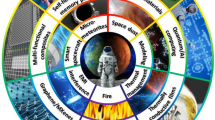Abstract
For the future energy system, we propose a new closed nuclear energy cycle system, which consists of an accelerator-driven external neutron source, a ceramic reactor and an extend AIROX reprocessing. The attractive features of this system are as follows. (1) The operating mode of the reactor is a combination of subcritical mode and critical mode. Initially, the reactor would be driven by the accelerator external neutron source in subcritical mode. A few years later, the reactor would reach the critical mode, and then would operate for a long time. (2) Nuclear fuels, coolants, and structure materials in the ceramic reactor core are made up of ceramic with excellent thermodynamics properties and neutron performance. Therefore, the ceramic reactor has extremely inherent safety, good breeding performance and high power generation efficiency. (3) Fuel reprocessing uses an extend AIROX reprocessing, which is a simple high-temperature dry process and rarely involved in chemical process. In this reprocessing, only most of fission products are separated. Other isotopes, including uranium isotopes, transuranic nuclides and long-lived fission products, would re-enter the reactor as new fuels. Therefore, this closed nuclear energy system could be known as ADANES, short for Accelerator-Driven Advanced Nuclear Energy System, which can greatly improve the utilization rate of nuclear fuels, enhance the nuclear safety, reduce the nuclear proliferation and become a sustainable and low-carbon energy supply for thousands of years.
Similar content being viewed by others
References
Chu S, Majumdar A. Opportunities and challenges for a sustainable energy future. Nature, 2012, 488: 294–303
International Energy Agency. World energy outlook 2015. International Energy Agency Report, 2015
British Petroleum. BP statistical review of world energy. British Petroleum Report, 2016
OECD. Uranium 2014: Resources, production and demand. OECD Report, 2014
The Generation IV International Forum. The Generation IV International Forum Annual Report, 2015
The Generation IV International Forum. Technology Roadmap Update for Generation IV Nuclear Energy Systems. The Generation IV International Forum Report, 2014
Schleicher R W, Choi H, Rawls J. The energy multiplier module: Advancing the nuclear fuel cycle through technology innovations. Nucl Tech, 2013, 184: 169–180
Ellis T, Petroski R, Hejzlar P, et al. Traveling-wave reactors: A truly sustainable and full-scale resource for global energy needs. In: Proceedings of ICAPP. San Diego, 2010
Rubbia C, Aleixandre J, Andriamonje S. A European roadmap for developing accelerator driven systems for nuclear waste incineration. ENEA Report, 2001
Majumdar D, Jahshan S N, Allison C M, et al. Recycling of Nuclear Spent Fuel with AIROX Processing. Department of Energy’s Report, 1992
Lu K. Materials in Energy Conversion, Harvesting, and Storage. Hoboken: John Wiley & Sons, Inc., 2014
Zhan W L, Xu H S. Advanced fission energy program—ADS transmutation system. Bull Chin Acad Sci, 2012, 27: 375–381
Abderrahim H A, Galambos J, Gohar Y, et al. Accelerator and target technology for accelerator driven transmutation and energy production. DOE white paper on ADS, 2010
Yang L, Zhan W L. New concept for ADS spallation target: Gravity-driven dense granular flow target. Sci China Tech Sci, 2015, 58: 1705–1711
Taylor P, Mceachern R J. Process to remove rare earths from spent nuclear fuel. US Patent 5597538, 1997–01-28
Zhang X C, Qi J, Zhang Y L, et al. Development of MCADS code and ADS benchmark calculation. Nucl Phys Rev, 2014, 31: 555–560
Yan X S, Qi J, Yang L, et al. Monte Carlo burn-up code system MCADS and its application. In: 22nd International Conference on Nuclear Engineering. Prague, 2014
Do Nascimento J A, Guimarães L N F, Ono S. Fuel, structural material and coolant for an advanced fast micro-reactor. In: International Nuclear Atlantic Conference. Belo Horizonte, 2011
Accelerator-driven systems and fast reactors in advanced nuclear fuel cycles report. OECD-NEA Report, 2002
Actinide and fission products partitioning and transmutation. OECDNEA Report, 1999
Committee on Separations Technology and Transmutation Systems. Nuclear Wastes: Technologies for Separations and Transmutation. Washington DC: National Academy Press, 1996
Yvon P, Carré F. Structural materials challenges for advanced reactor systems. J Nucl Mater, 2009, 385: 217–222
Siahpush A, Sabharwall P. ASME material challenges for advanced reactor concepts. In: Proceedings of the ASME 2013 Heat Transfer Summer Conference. Minneapolis, 2013
Author information
Authors and Affiliations
Corresponding author
Rights and permissions
About this article
Cite this article
Yang, L., Zhan, W. A closed nuclear energy system by accelerator-driven ceramic reactor and extend AIROX reprocessing. Sci. China Technol. Sci. 60, 1702–1706 (2017). https://doi.org/10.1007/s11431-017-9089-0
Received:
Accepted:
Published:
Issue Date:
DOI: https://doi.org/10.1007/s11431-017-9089-0




